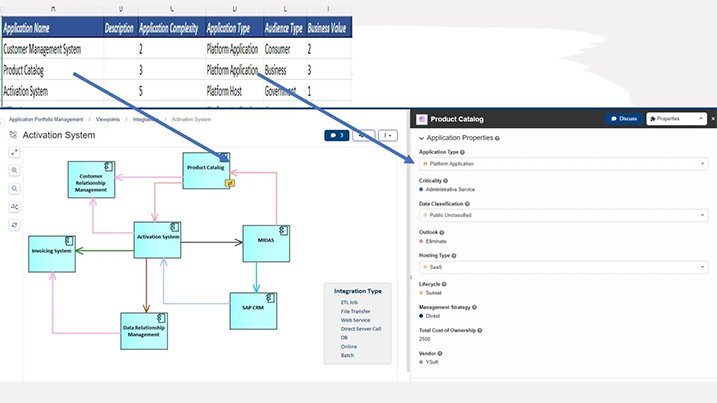Bridging the Gap Between Excel and Architecture Modeling
Overview
Many people use Microsoft Excel to keep track of the Enterprise applications, capabilities, data entities, etc. Users can import data from Excel into the Sparx Architecture Platform to build Model Information. The Essential Architecture Framework for implementing Application Portfolio Management and business Capability Management use cases using the Sparx Architecture Platform uses this ability to import from Excel. Also, it brings in automation functionalities that simplify Diagram generation and Dashboards.
This model creation from Excel involves creating templates, defining profiles, importing data, etc. This article elaborates on how this mapping from Excel to Model can be achieved.
Common Excel User Challenges
- Maintaining a single source of truth
- Granular access when shared via SharePoint or other techniques.
- Conducting Structured Reviews
- Managing dependencies across data layers such as Business, Application, Information, and Technology.
Sparx System has developed The Essential Architecture Framework, an Archimate-based lean modeling framework (Metamodel) with a pre-defined set of properties, which is widely used across Fortune companies around the globe. The Essential Architecture (TEA) Framework is a comprehensive framework from Sparx Prolaborate plans to contribute to various use cases such as Application Portfolio Management, Business Capability Assessment, Technology Portfolio Management, and more. The Essential Architecture framework goal is to simplify the tool’s initial setup, such as tool-centric aspects, streamlining configurations to guide Enterprise Architects effectively, and bringing in data teams that can quickly derive meaningful value, with the option to extend later.
Prolaborate leverages The Essential Architecture Framework to provide a head start for teams, eliminating weeks of upfront effort and helping them see value sooner. Historically, we at Prolaborate aimed to build a state-of-the-art platform applicable to various architectural use cases. However, preparing the tool for specific use cases has been challenging for Customers. Our recent launch of the APM accelerator has proven that teams need some framework to solve these kinds of struggles.

| Name | Definition |
|---|---|
| Template | An Excel sheet that contains data (plain text) in a structured format. Each Row represents an artifact, and columns represent the properties of each artifact. |
| Profile | A profile is a definition file that captures the mapping between template information and metamodel. The profile acts as a manual for converting data to model information. |
| MDG Office Add-in | An Add-in that helps in transforming plain text data to model information |
| Repository | A repository is a database where model information is stored. It acts as a single source of Truth. |
| EA/ EA SaaS | Enterprise Architect widely modeling tool that allow modelers to track their modeling progress. These tools are accessible within the standard EA application, and with connectivity, to PCS the ability to engage modelers from widely dispersed locations over cloud connections is greatly enhanced. The primary audience for EA is the modelers themselves, the people building the model, and the people who understand UML/SysML/BPMN/ Archimate and its intricacies. This level of collaboration is very tightly coupled with the model and focuses primarily on the construction of the model. |
| PCS | Pro Cloud Server provides seamless remote access to Enterprise Architect models. It opens your entire enterprise to your modeling efforts, enabling all levels of stakeholders to have secure remote access for different levels of collaboration and make the best use of enterprise models. |
| Prolaborate | Prolaborate is a collaborative platform designed for the business, executives, staff, and others in the enterprise/organization who may not have experience building models. Instead, they are the consumers of the model, applying the modeled structures and processes to their daily work. This includes everyone from C-level executives to those running critical business processes. |
Let us understand how the whole thing works. Once the customer gathers data in a template (refer to download APM accelerator package), they must define a template-specific profile. The profile captures mappings between column names and properties, tagged values, element types, connector types, and more.
Launch EA and select the repository for data loading. Launch MDG Office Add-in, and import the data as a model using the profile and template.
For a detailed demo of converting data to a model, watch the Application Portfolio Management Implementation video.

As you can see, the aftermath of importing the plain text in Excel is just transformed as an artifact in Prolaborate. For example, the template has a row with the Application Name ‘Product Catalog’ with attributes (column names) such as Description, Application Complexity, Application Type, Audience Type, and Business Value. After import, you can see such values on the properties window.
For more details, visit write toolbar support[at]prolaborate[dot]com. If you wish to book a demo, click the button below.




